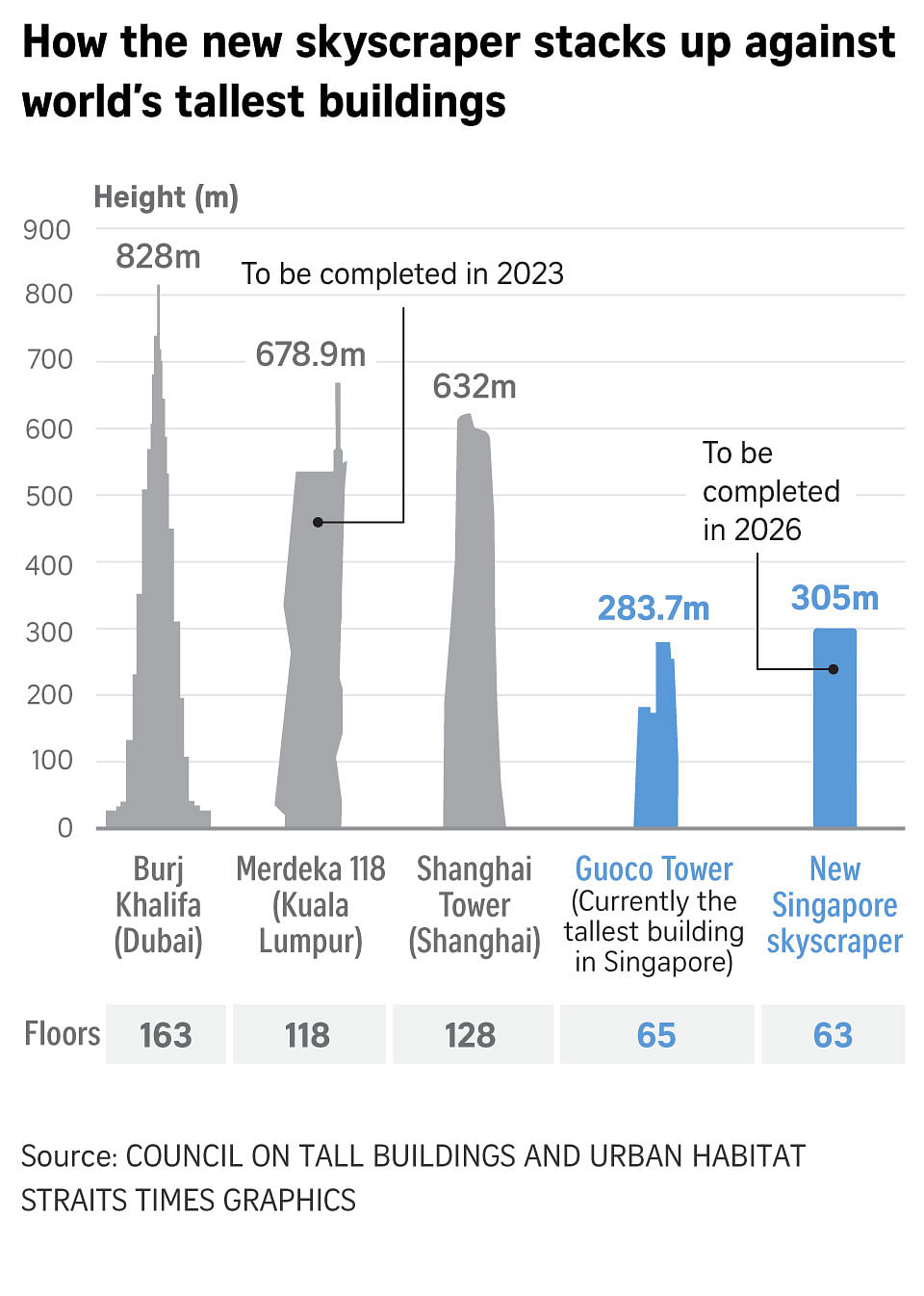US firm behind Burj Khalifa to work with local architects to design Singapore's tallest building
Sign up now: Get ST's newsletters delivered to your inbox

Skidmore, Owings & Merrill has been engaged to redevelop the former AXA Tower site into a 63-storey project.
ST PHOTO: LIM YAOHUI
Follow topic:
SINGAPORE - The American architecture firm behind Dubai's famed Burj Khalifa tower will design what will be Singapore's tallest skyscraper.
The Straits Times understands that Skidmore, Owings & Merrill (SOM) has been engaged by Chinese tech giant Alibaba Group Holding and a Perennial Holdings-led consortium to redevelop the former AXA Tower site at 8 Shenton Way into a 63-storey office, retail, residential and hotel project.
SOM, which has earned a reputation for creating ultra-tall structures, will partner Singapore's DCA Architects for the 305m-high development, which will dethrone the Guoco Tower as the city's tallest building once completed by 2026.
SOM designed New York's One World Trade Centre - the seventh tallest building in the world - and Tianjin CTF Finance Centre, the eighth tallest.
The firm was also engaged by Alibaba to design its new headquarters in Shanghai's Xuhui district.
SOM, DCA Architects and Perennial declined to comment on the new project.
DCA Architects worked with SOM on One George Street in Raffles Place and is partnering the firm on the Elementum project in Biopolis.
In July, the Urban Redevelopment Authority (URA) gave the green light for the Shenton Way skyscraper to reach a maximum height of 305m - 21.3m taller than the 283.7m Guoco Tower, designed by SOM and completed in 2016.
The project is expected to obtain its temporary occupation permit in 2026, according to URA's Realis database.
The race is always on to build taller buildings, say architects.
Mr Lawrence Ler, founder and principal architect at Taler Studio + Architects, said: "There is a direct relationship between land cost and return on investment from a taller building.
"This is most evident in Singapore, where developers must intensely develop the land to make sure it is able to offset the high costs of land and construction.
"In addition, tall buildings serve as a symbol of economic success of a city or country... even though they may not be practical or profitable."
Take Shanghai Tower, which will drop from the world's second to third tallest building after Merdeka 118 in Kuala Lumpur is completed next year.

The Shanghai block faced a myriad of problems when completed in 2016. It reportedly suffered a low occupancy rate as the round design is less efficient than a square floor plate, resulting in a lot of unused space.
DCA Architects managing director Vincent Koo Tin Chew said: "Tall buildings are conceived with their distinct character and unique design to... stand out in the city skyline. The building form, facade expression, type of material, and use of sky gardens are the means to make an impression on the Singapore skyline."
Mr Ler, who designed the Henderson Waves bridge, said the vast majority of the world's skyscrapers are less than 300m.
The Council of Tall Buildings and Urban Habitat database notes that there are only four in the world that exceed 600m.

Building height in Singapore is governed by bodies such as the Civil Aviation Authority of Singapore and Defence Science and Technology Agency.
Developers tend to maximise the allowable height, said Mr Teo Yee-Chin, managing partner of Red Bean Architects and former chief editor of The Singapore Architect magazine.
Taller buildings mean more floor area and better quality offices as ceilings can be higher.
The views are better as well and so can fetch higher rent, said Mr Teo, who noted that developers here tend to favour more squarish designs to maximise floor space.
Generally, factors such as elevator technology, building material, comfort and money will determine how tall a building can go.
Mr Koo said: "Tall buildings tend to be mixed-use to fit within tight urban sites, especially in land-scarce Singapore.
"The sky gardens separate the different user groups in a single tower building to optimise the layout of the respective components. However, it results in a complex structure with the transfer of columns and services."
Singapore's aim to achieve net-zero carbon emissions by 2050 will make it challenging to achieve sustainability in building construction: The taller the development, the more energy will be consumed.
Mr Teo noted: “Other than structure, the mechanical systems for tall buildings need to be advanced. For example, to go up 300m, the developer would not use the same elevators as for a 30-storey condominium. It would take more than 10 minutes to get to the higher floors. The elevators need to be of super-high speed and are definitely much costlier.
“The building will also need to incorporate powerful pumping systems for irrigation and sanitation up the super-tall tower, which will also be more expensive.”

